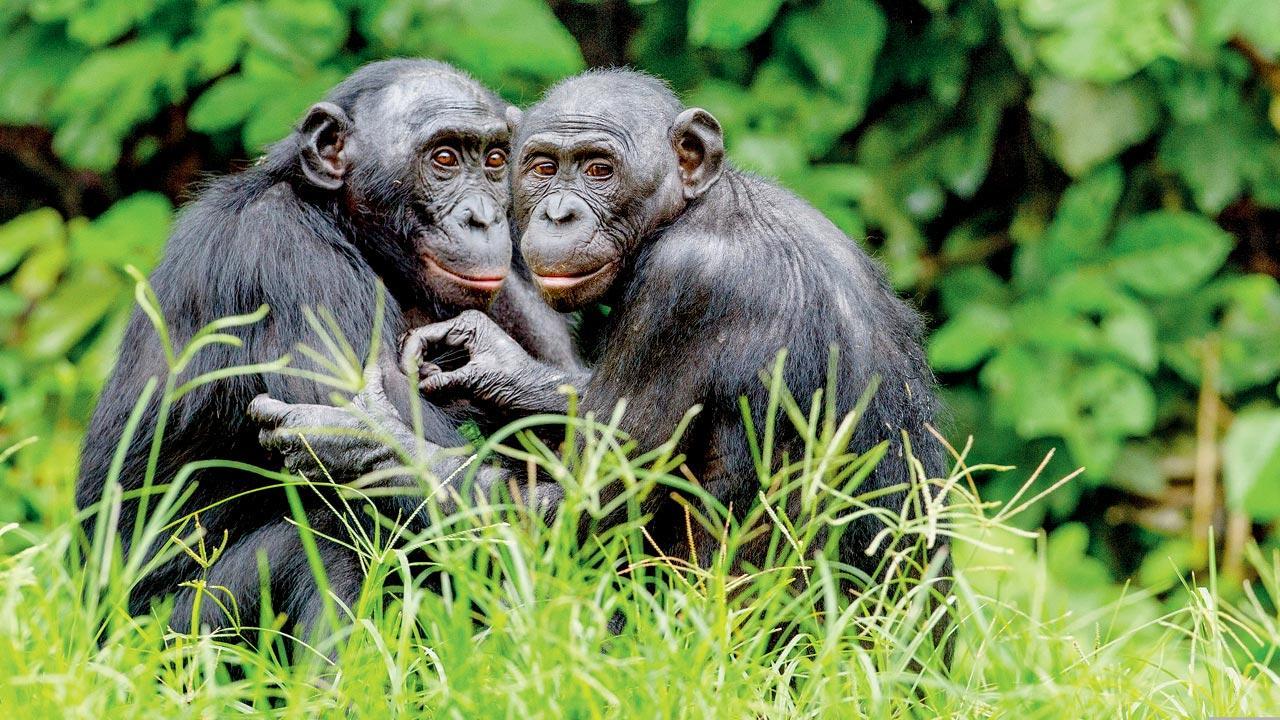Leading neuroscientist Simon LeVay’s fascinating new book says sexual orientation could be determined by genes, why lizards get by without sex, and how oxytocin and vasopressin could be key to falling in love

Research shows that among bonobo or pygmy chimpanzees, who engage in a great deal of sex, such sexual behaviour helps resolve conflicts, which allows natural resources to be shared more efficiently among them
Science might not have all the answers, but when it comes to seeking truths about sex, British-American neuroscientist Simon LeVay feels that the “scientific method is the best way forward”. LeVay, who has served on the faculties of Harvard Medical School, Boston and the Salk Institute for Biological Studies, California, is best known for his sensational 1991 report that documented a tiny difference in brain structure between homosexual and straight men. His research pointed to how a tiny cell cluster in the brain, known as the third interstitial nucleus of the anterior hypothalamus, or INAH3, which “is deeply involved in regulating male-typical sex behaviour,” was bigger in straight men; the gay men’s cell clusters were in the same size range as women’s. A feature published in the Discover Magazine in 1994, claimed that the study had “catapulted him [LeVay] from his scientific ivory tower into the heated fray of homosexual politics”.
ADVERTISEMENT
Nearly 32 years later, his fame notwithstanding, LeVay remains just as deeply invested and curious about research around sex and human sexuality. His just-released title Attraction, Love, Sex: The Inside Story (Bloomsbury India) reveals how, world over, scientists like him are unravelling the secrets of sex and sexuality, and in the process, shattering traditional ideas and prejudices. “Much of the research on sexuality is published in academic papers that are difficult for non-scientists to access or understand,” he tells mid-day in an email interview. “Yet buried in this enormous body of research are clues to some important mysteries about sex.” With his new book, LeVay says he wanted to describe the progress that is being made in finding the answers.
The central mystery of sex, says LeVay, is why we reproduce sexually. “To investigate this mystery, I reviewed research that is being done in species ranging from single-celled yeast to vertebrates such as lizards.” Lizards seem to get along fine without sex. “All these lizards are female and they reproduce by virgin birth [asexual reproduction]. In fact, this could be advantageous in evolutionary terms, because it doesn’t require the existence of males. Yet most species do reproduce sexually, either some of the time or [as in our own species] as their only form of reproduction,” he says. Sexual reproduction, he explains, involves the mixing of genes from two parents. “The most likely explanation for the existence of sexual reproduction, in my opinion, is that this mixing allows for the removal of harmful mutations in a species’ genes—mutations that would otherwise accumulate over the generations. Asexual species may crop up now and then and flourish for many generations, but over a long period of time, they are likely to go extinct.”
 Simon Levay
Simon Levay
Over the course of evolution, however, some species have developed functions for sex that have no direct reproductive purpose. “For example, our close relatives the bonobos engage in a great deal of sex between females and males. I discuss research indicating that these seemingly useless forms of sexual behaviour are in fact advantageous in evolutionary terms. In bonobos, they appear to help resolve conflicts, which allow resources to be shared more efficiently,” he says.
In the area of sexual orientation research itself, newer and important benchmarks have been set since his own pioneering work. LeVay, who identifies as gay, alludes to the 2019 scientific report by Italian geneticist Andrea Ganna and his colleagues. “Using genetic data from several hundred thousand individuals, Ganna found that genes account for about one-third of the total causation of a person’s sexual orientation. He also identified several locations within the genome where genes influencing sexual orientation [either in males, females, or both sexes] are located. Nevertheless, his work indicates that ‘gay genes’—individual genes that act like switches to determine a person’s sexuality—must be rare if they exist at all. Rather, numerous genes, each having a weak effect, act through complex networks during pre- and postnatal life to establish a person’s orientation.”
LeVay, who has written/co-written over 12 books in the past, also delves into the science behind relationships, arousal, love and attraction. Exploring the latter, he takes us through studies that point to how it is “closely linked to the stomach, odours, and even facial symmetry”. The results, however, are a mixed bag and even LeVay feels should be taken with a pinch of salt.
“Two groups of researchers did this experiment: They showed outlines of female figures varying in fatness to male college students who were either hungry or who had just eaten. In both studies, the hungry students judged the fatter figures more attractive than did the students who were full,” shares LeVay, adding, “This finding goes along with a large body of evidence that judgments of attractiveness can be modified depending on the circumstances of the person doing the judging. In contrast, some aspects of facial attractiveness, such as symmetry, seem to be fixed. This suggests that symmetrical faces are indicators of healthy development, so that preferring such faces may be adaptive in evolutionary terms.”
According to him, the fact that both research groups got the same result strengthens the believability of the finding. “In other cases, research groups have reported conflicting findings. That’s true for some ‘sweaty T-shirt’ studies: One Swiss research group found that men rate the odour of T-shirts worn by women most attractive if the women differ in certain genes from those of the raters, while another group at the same university failed to find any relationship between attractiveness and genetic similarity. That’s part of the scientific process: One of those studies must be wrong, but we don’t know which, and it will take further studies to resolve the conflict.” He, however, rues the fact that research has paid very little attention to the opposite of sexual attraction, which is sexual aversion or sexual disgust.
Love—“which is not the same thing as sexual attraction”—that emotion that has confounded mankind since eons, also finds room in the science laboratory. “It is a desire for union with another person, and consists of passion, intimacy, and commitment in variable proportions,” LeVay says, adding, “People often use the word ‘chemistry’ to explain what attracts lovers to each other, and the science bears that out: research in prairie voles—small rodents that form lasting pair bonds—has demonstrated a key role for two brain chemicals, oxytocin and vasopressin, in sexual pair-bonding. Another brain chemical, dopamine, also plays an important role. These chemicals are not released at random within the brain but within complex synaptic networks that are currently being deciphered.” Much about love, he says, is still a mystery—but maybe not for much longer.
 Subscribe today by clicking the link and stay updated with the latest news!" Click here!
Subscribe today by clicking the link and stay updated with the latest news!" Click here!







